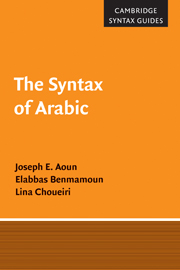Book contents
- Frontmatter
- Contents
- List of abbreviations
- 1 Issues in the syntax of Arabic
- 2 Clause structure in Arabic
- 3 The syntax of subjects
- 4 Sentential agreement
- 5 The syntax of sentential negation
- 6 Modes of wh-interrogation
- 7 Restrictive relatives
- 8 Clitic-left dislocation and focus constructions
- 9 The syntax of the Arabic left periphery
- References
- Index
2 - Clause structure in Arabic
Published online by Cambridge University Press: 30 March 2010
- Frontmatter
- Contents
- List of abbreviations
- 1 Issues in the syntax of Arabic
- 2 Clause structure in Arabic
- 3 The syntax of subjects
- 4 Sentential agreement
- 5 The syntax of sentential negation
- 6 Modes of wh-interrogation
- 7 Restrictive relatives
- 8 Clitic-left dislocation and focus constructions
- 9 The syntax of the Arabic left periphery
- References
- Index
Summary
Introduction
One of the distinguishing features of the Principles and Parameters framework is the fundamental assumption that syntactic configurations expressing hierarchical relations between heads and their surrounding constituents are key to capturing generalizations involving Case assignment, agreement relations, argument selection, polarity licensing, restrictions on displacement, and perhaps word order and other properties. However, there is no consensus as to how to account for the variation that clauses display cross-linguistically or even within the same language. Under some approaches, languages differ as to whether a particular element heads a syntactic projection in the syntax. This issue has been extensively debated in the context of categories such as agreement (Pollock 1989; Ouhalla 1991; Benmamoun 1992a; Iatridou 1990; Chomsky 1995; Cinque 1999). The same question arises in the context of tense and VP. For example, in some languages there is neither an overt tense marker nor a copula in the present tense, leading some approaches to claim that there is neither a TP (Tense Phrase) nor a VP projection in such constructions, which in turn implies that the TP and VP projections may not be universal. Arabic dialects are good testing grounds for this debate. They display a temporal system that is not easy to characterize morphologically and they do not have a verbal copula in the present tense.
- Type
- Chapter
- Information
- The Syntax of Arabic , pp. 12 - 45Publisher: Cambridge University PressPrint publication year: 2009



